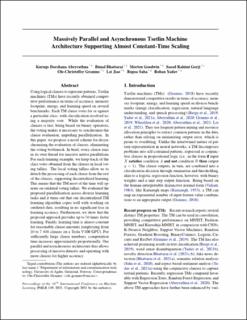Massively Parallel and Asynchronous Tsetlin Machine Architecture Supporting Almost Constant-Time Scaling
Abeyrathna, Kuruge Darshana; Bhattarai, Bimal; Goodwin, Morten; Gorji, Saeed Rahimi; Granmo, Ole-Christoffer; Lei, Jiao; Saha, Rupsa; Yadav, Rohan Kumar
Peer reviewed, Journal article
Submitted version
Permanent lenke
https://hdl.handle.net/11250/2993140Utgivelsesdato
2021Metadata
Vis full innførselSamlinger
Originalversjon
Abeyrathna, K. D., Bhattarai, B., Goodwin, M., Gorji, S. R., Granmo, O.-C., Lei, J., Saha, R. & Yadav, R. K. (2021). Massively Parallel and Asynchronous Tsetlin Machine Architecture Supporting Almost Constant-Time Scaling. Proceedings of Machine Learning Research (PMLR), 11.Sammendrag
Using logical clauses to represent patterns, Tsetlin Machine (TM) have recently obtained competitive performance in terms of accuracy, memory footprint, energy, and learning speed on several benchmarks. Each TM clause votes for or against a particular class, with classification resolved using a majority vote. While the evaluation of clauses is fast, being based on binary operators, the voting makes it necessary to synchronize the clause evaluation, impeding parallelization. In this paper, we propose a novel scheme for desynchronizing the evaluation of clauses, eliminating the voting bottleneck. In brief, every clause runs in its own thread for massive native parallelism. For each training example, we keep track of the class votes obtained from the clauses in local voting tallies. The local voting tallies allow us to detach the processing of each clause from the rest of the clauses, supporting decentralized learning. This means that the TM most of the time will operate on outdated voting tallies. We evaluated the proposed parallelization across diverse learning tasks and it turns out that our decentralized TM learning algorithm copes well with working on outdated data, resulting in no significant loss in learning accuracy. Furthermore, we show that the approach provides up to 50 times faster learning. Finally, learning time is almost constant for reasonable clause amounts (employing from 20 to 7,000 clauses on a Tesla V100 GPU). For sufficiently large clause numbers, computation time increases approximately proportionally. Our parallel and asynchronous architecture thus allows processing of more massive datasets and operating with more clauses for higher accuracy.
